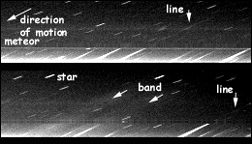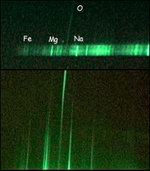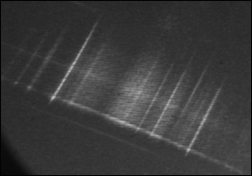|
Leonid MAC |
| home |
| View the shower |
| Mission Brief |
| Science Update |
| Media Brief |
| links |
LEONID DAILY NEWS: November 22, 2002

Figure 1: Optical spectrum of the 05:15:16 UT Leonid. The SETI Institute cooled CCD spectrograph (P. Jenniskens, P.I.) was very successful in capturing optical spectra of Leonid meteors during the 2002 Leonid MAC mission. The instrument was operated by Emily Schaller of Caltech, who captured the particularly nice result shown above. This meteor shows a newly discovered molecular band emission in an early part of its trajectory, idenfied as the molecular oxygen B-band, where the metal atom ablation lines are still weak.
SPECTRA OF FAINT METEORS Faint meteors were targeted by the NASA Ames code JIT videographers Greg Merkes and Jesse Carpenter onboard FISTA, who filmed hundreds of spectra of intrinsically faint meteors with a High Definition TV camera and the SETI Institute low-resolution spectrograph. Sometimes, a bright meteor is also captured. The figure above shows afterglow and recombination lines, discovered in prior campaigns by Jiri Borovicka and Peter Jenniskens.
HUNDREDS OF LOW RESOLUTION SPECTRA RECORDED Jiri Borovicka reports that the Ondrejov video spectrometer worked well. At least 130 low resolution meteor spectra of various quality were obtained during the first 90 minutes of observation, which included the 4 UT peak. A summary image of one of the best spectra is shown. This completes homogeneous material of Leonid video spectra taken with the same camera in 5 different years (1998-2002). These data will be used to compare meteors from various trails, mainly in respect of the Na/Mg/Fe ratios and of the effect of early release of sodium.
2002: Nov 22 - New molecular band detected Nov 21 - Leonids tracked Nov 20 - Asteroids named after Leonid MAC participants Nov 19 - Leonid storms rich in faint meteors Oct 22 - Collecting meteoroid debris from snow cover Oct 21 - Highlights COSPAR/World Space Congress Aug 31 - First UV spectrum: Leonid from space 2001: Dec 11 - Shocking Leonid Dec 01 - Moon impacts Nov 26 - Near-IR persistent train emission Nov 24 - Results of near-real time flux measurements Nov 22 - Wowh! Optical meteor spectra 2000: Dec. 25 - Ursid shower circular IMO Dec. 24 - Ursid shows early release of sodium Dec. 23 - Ursid outburst confirmed Dec. 18 - Dec 22 Ursid outburst Nov. 20 - A bacterial fingerprint? Nov. 15 - HCN disappears mysteriously Nov. 14 - Meteor shower from space Nov. 13 - Organic fingerprint Nov. 12 - Train airglow chemistry Nov. 11 - Hard bits and persisting glows Nov. 10 - Meteoroid debris detected Nov. 09 - New meteor picture Nov. 08 - Spin city Nov. 07 - Meteors affect atmospheric chemistry Nov. 06 - Listen to this! Nov. 04 - Fear of heights? Nov. 03 - The pale (infra-red) dot Nov. 02 - Twin showers Nov. 01 - Leonids approaching Earth Oct. 31 - Prospects for Moon Impact Studies Oct. 30 - Comet dust crumbled less fine Today's news
| ||

 Figure 2: Leonid meteor and afterglow
Figure 2: Leonid meteor and afterglow
 Figure 3: Optical spectrum of the -1 magnitude 04:24:20 UT Leonid, observed
visually through the aircraft window.
Figure 3: Optical spectrum of the -1 magnitude 04:24:20 UT Leonid, observed
visually through the aircraft window.
